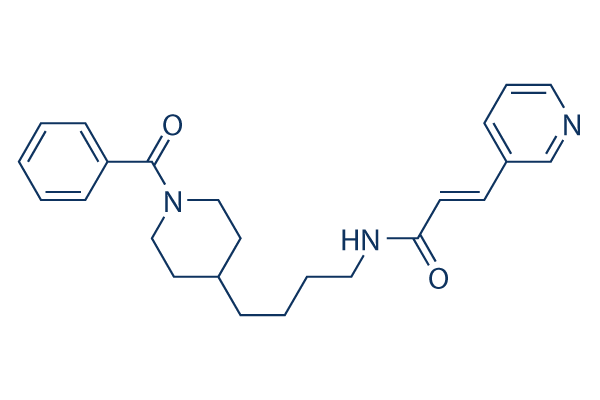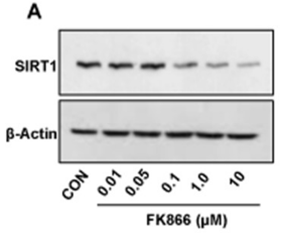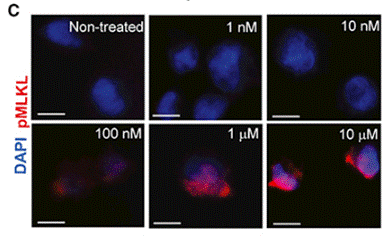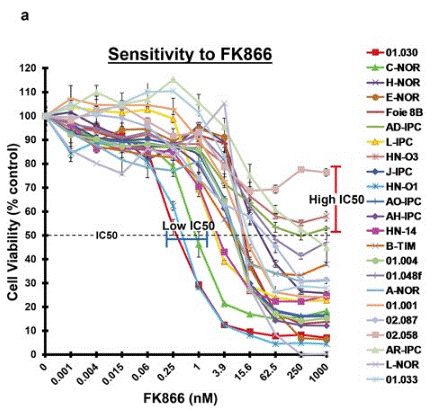
- Inhibitors
- By product type
- Natural Products
- Inducing Agents
- Peptides
- Antibiotics
- Antibody-drug Conjugates(ADC)
- PROTAC
- Hydrotropic Agents
- Dyes
- By Signaling Pathways
- PI3K/Akt/mTOR
- Epigenetics
- Methylation
- Immunology & Inflammation
- Protein Tyrosine Kinase
- Angiogenesis
- Apoptosis
- Autophagy
By research - Antibodies
- Compound Libraries
- Popular Compound Libraries
- Customize Library
- Clinical and FDA-approved Related
- Bioactive Compound Libraries
- Inhibitor Related
- Natural Product Related
- Metabolism Related
- Cell Death Related
- By Signaling Pathway
- By Disease
- Anti-infection and Antiviral Related
- Neuronal and Immunology Related
- Fragment and Covalent Related
- FDA-approved Drug Library
- FDA-approved & Passed Phase I Drug Library
- Preclinical/Clinical Compound Library
- Bioactive Compound Library-I
- Bioactive Compound Library-Ⅱ
- Kinase Inhibitor Library
- Express-Pick Library
- Natural Product Library
- Human Endogenous Metabolite Compound Library
- Alkaloid Compound LibraryNew
- Angiogenesis Related compound Library
- Anti-Aging Compound Library
- Anti-alzheimer Disease Compound Library
- Antibiotics compound Library
- Anti-cancer Compound Library
- Anti-cancer Compound Library-Ⅱ
- Anti-cancer Metabolism Compound Library
- Anti-Cardiovascular Disease Compound Library
- Anti-diabetic Compound Library
- Anti-infection Compound Library
- Antioxidant Compound Library
- Anti-parasitic Compound Library
- Antiviral Compound Library
- Apoptosis Compound Library
- Autophagy Compound Library
- Calcium Channel Blocker LibraryNew
- Cambridge Cancer Compound Library
- Carbohydrate Metabolism Compound LibraryNew
- Cell Cycle compound library
- CNS-Penetrant Compound Library
- Covalent Inhibitor Library
- Cytokine Inhibitor LibraryNew
- Cytoskeletal Signaling Pathway Compound Library
- DNA Damage/DNA Repair compound Library
- Drug-like Compound Library
- Endoplasmic Reticulum Stress Compound Library
- Epigenetics Compound Library
- Exosome Secretion Related Compound LibraryNew
- FDA-approved Anticancer Drug LibraryNew
- Ferroptosis Compound Library
- Flavonoid Compound Library
- Fragment Library
- Glutamine Metabolism Compound Library
- Glycolysis Compound Library
- GPCR Compound Library
- Gut Microbial Metabolite Library
- HIF-1 Signaling Pathway Compound Library
- Highly Selective Inhibitor Library
- Histone modification compound library
- HTS Library for Drug Discovery
- Human Hormone Related Compound LibraryNew
- Human Transcription Factor Compound LibraryNew
- Immunology/Inflammation Compound Library
- Inhibitor Library
- Ion Channel Ligand Library
- JAK/STAT compound library
- Lipid Metabolism Compound LibraryNew
- Macrocyclic Compound Library
- MAPK Inhibitor Library
- Medicine Food Homology Compound Library
- Metabolism Compound Library
- Methylation Compound Library
- Mouse Metabolite Compound LibraryNew
- Natural Organic Compound Library
- Neuronal Signaling Compound Library
- NF-κB Signaling Compound Library
- Nucleoside Analogue Library
- Obesity Compound Library
- Oxidative Stress Compound LibraryNew
- Plant Extract Library
- Phenotypic Screening Library
- PI3K/Akt Inhibitor Library
- Protease Inhibitor Library
- Protein-protein Interaction Inhibitor Library
- Pyroptosis Compound Library
- Small Molecule Immuno-Oncology Compound Library
- Mitochondria-Targeted Compound LibraryNew
- Stem Cell Differentiation Compound LibraryNew
- Stem Cell Signaling Compound Library
- Natural Phenol Compound LibraryNew
- Natural Terpenoid Compound LibraryNew
- TGF-beta/Smad compound library
- Traditional Chinese Medicine Library
- Tyrosine Kinase Inhibitor Library
- Ubiquitination Compound Library
-
Cherry Picking
You can personalize your library with chemicals from within Selleck's inventory. Build the right library for your research endeavors by choosing from compounds in all of our available libraries.
Please contact us at info@selleckchem.com to customize your library.
You could select:
- Bioreagents
- qPCR
- 2x SYBR Green qPCR Master Mix
- 2x SYBR Green qPCR Master Mix(Low ROX)
- 2x SYBR Green qPCR Master Mix(High ROX)
- Protein Assay
- Protein A/G Magnetic Beads for IP
- Anti-Flag magnetic beads
- Anti-Flag Affinity Gel
- Anti-Myc magnetic beads
- Anti-HA magnetic beads
- Poly DYKDDDDK Tag Peptide lyophilized powder
- Protease Inhibitor Cocktail
- Protease Inhibitor Cocktail (EDTA-Free, 100X in DMSO)
- Phosphatase Inhibitor Cocktail (2 Tubes, 100X)
- Cell Biology
- Cell Counting Kit-8 (CCK-8)
- Animal Experiment
- Mouse Direct PCR Kit (For Genotyping)
- Featured Products
- MRTX1133
- Nab-Paclitaxel
- KP-457
- IAG933
- RMC-6236 (Daraxonrasib)
- RMC-7977
- Zoldonrasib (RMC-9805)
- GsMTx4
- Navitoclax (ABT-263)
- TSA (Trichostatin A)
- Y-27632 Dihydrochloride
- SB431542
- SB202190
- MK-2206 Dihydrochloride
- LY294002
- Alisertib (MLN8237)
- XAV-939
- CHIR-99021 (Laduviglusib)
- Bafilomycin A1 (Baf-A1)
- Thiazovivin (TZV)
- CP-673451
- Verteporfin
- DAPT
- Galunisertib (LY2157299)
- MG132
- SBE-β-CD
- Tween 80
- Bavdegalutamide (ARV-110)
- Z-VAD-FMK
- Wnt-C59 (C59)
- IWR-1-endo
- (+)-JQ1
- 3-Deazaneplanocin A (DZNep) Hydrochloride
- RepSox (E-616452)
- Erastin
- Q-VD-Oph
- Puromycin Dihydrochloride
- Cycloheximide
- Telaglenastat (CB-839)
- A-83-01
- Ceralasertib (AZD6738)
- Liproxstatin-1
- Emricasan (IDN-6556)
- PMA (Phorbol 12-myristate 13-acetate)
- Dibutyryl cAMP (Bucladesine) sodium
- Nedisertib (M3814)
- PLX5622
- IKE (Imidazole Ketone Erastin)
- STM2457
- Saruparib (AZD5305)
- New Products
- Contact Us
research use only
FK866 (Daporinad) Nampt inhibitor
Cat.No.S2799

Chemical Structure
Molecular Weight: 391.51
Quality Control
Batch:
Purity:
99.99%
99.99
Products Often Used Together with FK866 (Daporinad)
Cell Culture, Treatment & Working Concentration
| Cell Lines | Assay Type | Concentration | Incubation Time | Formulation | Activity Description | PMID |
|---|---|---|---|---|---|---|
| SH-SY5Y | Cytotoxicity assay | Cytotoxicity against human SH-SY5Y cells assessed as reduction of total cellular NAD(P) level, IC50 = 0.0005 μM. | 19961183 | |||
| SH-SY5Y | Cytotoxicity assay | 48 hrs | Cytotoxicity against human SH-SY5Y cells assessed as cell viability after 48 hrs by MTT assay, IC50 = 0.0017 μM. | 19961183 | ||
| HT1080 | Cytotoxicity assay | 6 days | Cytotoxicity against human HT1080 cells after 6 days by SRB assay, IC50 = 0.16 μM. | 21330015 | ||
| A549 | Cytotoxicity assay | 6 days | Cytotoxicity against human A549 cells after 6 days by SRB assay, IC50 = 0.16 μM. | 21330015 | ||
| HCT116 | Cytotoxicity assay | 6 days | Cytotoxicity against human HCT116 cells after 6 days by SRB assay, IC50 = 0.16 μM. | 21330015 | ||
| SNU638 | Cytotoxicity assay | 6 days | Cytotoxicity against human SNU638 cells after 6 days by SRB assay, IC50 = 0.16 μM. | 21330015 | ||
| MCF7 | Antitumor assay | 10 uM | 6 days | Antitumor activity against human MCF7 cells at 10 uM after 6 days by SRB assay, IC50 = 0.68 μM. | 21330015 | |
| K562 | Cytotoxicity assay | 6 days | Cytotoxicity against human K562 cells after 6 days by SRB assay, IC50 = 20 μM. | 21330015 | ||
| A2780 | Cytotoxicity assay | 72 hrs | Cytotoxicity against human A2780 cells after 72 hrs by SRB assay, IC50 = 0.001 μM. | 23617784 | ||
| NYH | Cytotoxicity assay | 3 weeks | Cytotoxicity against human NYH cells after 3 weeks by clonogenic survival assay, LD50 = 0.0015 μM. | 23679915 | ||
| K562 | Cytotoxicity assay | 96 hrs | Cytotoxicity against human K562 cells after 96 hrs by MTT assay, IC50 = 0.0072 μM. | 23679915 | ||
| A2780 | Antiproliferative assay | 72 hrs | Antiproliferative activity against human A2780 cells assessed as growth inhibition after 72 hrs by SRB-based microplate reader analysis, IC50 = 0.001 μM. | 23859118 | ||
| NYH | Cytotoxicity assay | Cytotoxicity against human NYH cells by clonogenic assay, IC50 = 0.0015 μM. | 24164086 | |||
| A2780 | Cytotoxicity assay | 72 hrs | Cytotoxicity against human A2780 cells assessed as growth inhibition after 72 hrs by WST-1 assay, IC50 = 0.0016 μM. | 24164086 | ||
| HepG2 | Function assay | 1 hr | Inhibition of NAMPT in human HepG2 cells using [14C]-nicotinamide/PRPP as substrate assessed as formation of [14C]-nicotinamide mononucleotide after 1 hr by liquid scintillation counting analysis, IC50 = 0.0022 μM. | 24164086 | ||
| PC3 | Cytotoxicity assay | Cytotoxicity against human PC3 cells by clonogenic assay, IC50 = 0.0038 μM. | 24164086 | |||
| A2780 | Cytotoxicity assay | Cytotoxicity against human A2780 cells by clonogenic assay, IC50 = 0.0057 μM. | 24164086 | |||
| A431 | Cytotoxicity assay | Cytotoxicity against human A431 cells by clonogenic assay, IC50 = 0.0061 μM. | 24164086 | |||
| MCF-7 | Cytotoxicity assay | 72 hrs | Cytotoxicity against human MCF-7 cells assessed as growth inhibition after 72 hrs by WST-1 assay, IC50 = 0.0074 μM. | 24164086 | ||
| MCF7 | Cytotoxicity assay | Cytotoxicity against human MCF7 cells by clonogenic assay, IC50 = 0.0084 μM. | 24164086 | |||
| HCT116 | Cytotoxicity assay | 72 hrs | Cytotoxicity against human HCT116 cells assessed as growth inhibition after 72 hrs by WST-1 assay, IC50 = 0.0109 μM. | 24164086 | ||
| SKOV3 | Cytotoxicity assay | Cytotoxicity against human SKOV3 cells by clonogenic assay, IC50 = 0.211 μM. | 24164086 | |||
| HCT116 | Cytotoxicity assay | 72 hrs | Cytotoxicity against APO866-resistant human HCT116 cells assessed as growth inhibition after 72 hrs by WST-1 assay, IC50 = 0.946 μM. | 24164086 | ||
| A2780 | Antiproliferative assay | 72 hrs | Antiproliferative activity against human A2780 cells after 72 hrs by sulforhodamine B assay, IC50 = 0.001 μM. | 24405419 | ||
| A2780 | Function assay | 72 hrs | Inhibition of NAMPT in human A2780 cells assessed as decrease in cell viability after 72 hrs by SRB assay, IC50 = 0.001 μM. | 27541271 | ||
| DE3 | Function assay | 15 mins | Inhibition of human full length C-terminal His6-tagged NAMPT expressed in Escherichia coli Rosetta (DE3) cells using nicotinamide as substrate incubated for 15 mins prior to substrate addition measured after 30 mins in presence of PRPP, IC50 = 0.003 μM. | 27541271 | ||
| SH-SY5Y | Cytotoxicity assay | 56 hrs | Cytotoxicity against human SH-SY5Y cells assessed as reduction in cell viability after 56 hrs by MTT assay, EC50 = 0.0034 μM. | 28165742 | ||
| A2780 | Cytotoxicity assay | Cytotoxicity against human A2780 cells assessed as reduction in cell viability, IC50 = 0.0042 μM. | 28165742 | |||
| PC3 | Antiproliferative assay | 5 days | Antiproliferative activity against human PC3 cells assessed as reduction in cell viability incubated for 5 days by Cell-titer Glo reagent based assay, IC50 = 0.0057 μM. | 28610984 | ||
| HepG2 | Cytotoxicity assay | 72 hrs | Cytotoxicity in human HepG2 cells assessed as reduction in cell viability after 72 hrs by MTT assay, IC50 = 0.89 μM. | 28885834 | ||
| MDA-MB-231 | Cytotoxicity assay | 72 hrs | Cytotoxicity in human MDA-MB-231 cells assessed as reduction in cell viability after 72 hrs by MTT assay, IC50 = 1.3 μM. | 28885834 | ||
| HCT116 | Cytotoxicity assay | 72 hrs | Cytotoxicity in human HCT116 cells assessed as reduction in cell viability after 72 hrs by MTT assay, IC50 = 1.6 μM. | 28885834 | ||
| HepG2 | Cytotoxicity assay | 72 hrs | Cytotoxicity against human HepG2 cells assessed as inhibition of cell growth after 72 hrs by MTT assay, IC50 = 0.89 μM. | 29348808 | ||
| HCT116 | Cytotoxicity assay | 72 hrs | Cytotoxicity against human HCT116 cells assessed as inhibition of cell growth after 72 hrs by MTT assay, IC50 = 1.6 μM. | 29348808 | ||
| A549 | Cytotoxicity assay | 72 hrs | Cytotoxicity against human A549 cells assessed as inhibition of cell growth after 72 hrs by MTT assay, IC50 = 3.7 μM. | 29348808 | ||
| SH-SY5Y | Autophagy assay | 40 hrs | Induction of autophagy in human SH-SY5Y cells assessed as LC3/phosphotidylethanolamine coupling after 40 hrs by Western blot analysis | 19961183 | ||
| MCF7 | Antitumor assay | 6 days | Antitumor activity against human MCF7 cells after 6 days by SRB assay | 21330015 | ||
| MDCK | Function assay | 10 uM | Apparent permeability across apical to basolateral side in dog MDCK cells at 10 uM by LC-MS/MS analysis | 23859118 | ||
| DU145 | Cytotoxicity assay | Cytotoxicity against human DU145 cells by clonogenic assay | 24164086 | |||
| MCF7 | Cytotoxicity assay | 96 hrs | Cytotoxicity against human MCF7 cells after 96 hrs by clonogenic assay | 24164086 | ||
| HCT116 | Function assay | Resistance factor, ratio of IC50 for APO866-resistant human HCT116 cells to IC50 for human HCT116 cells | 24164086 | |||
| A2780 | Antiproliferative assay | 72 hrs | Antiproliferative activity against human A2780 cells after 72 hrs by sulforhodamine B assay in presence of nicotinamide mononucleotide | 24405419 | ||
| Sf9 | Function assay | 30 mins | Inhibition of recombinant full length human C-terminal His/flag-tagged HDAC1 expressed in baculovirus infected Sf9 insect cells after 30 mins by fluorescence assay | 29348808 | ||
| Click to View More Cell Line Experimental Data | ||||||
Chemical Information, Storage & Stability
| Molecular Weight | 391.51 | Formula | C24H29N3O2 |
Storage (From the date of receipt) | |
|---|---|---|---|---|---|
| CAS No. | 658084-64-1 | Download SDF | Storage of Stock Solutions |
|
|
| Synonyms | APO866 | Smiles | C1CN(CCC1CCCCNC(=O)C=CC2=CN=CC=C2)C(=O)C3=CC=CC=C3 | ||
Solubility
|
In vitro |
DMSO
: 78 mg/mL
(199.22 mM)
Ethanol : 78 mg/mL Water : Insoluble |
Molarity Calculator
|
In vivo |
|||||
In vivo Formulation Calculator (Clear solution)
Step 1: Enter information below (Recommended: An additional animal making an allowance for loss during the experiment)
mg/kg
g
μL
Step 2: Enter the in vivo formulation (This is only the calculator, not formulation. Please contact us first if there is no in vivo formulation at the solubility Section.)
% DMSO
%
% Tween 80
% ddH2O
%DMSO
%
Calculation results:
Working concentration: mg/ml;
Method for preparing DMSO master liquid: mg drug pre-dissolved in μL DMSO ( Master liquid concentration mg/mL, Please contact us first if the concentration exceeds the DMSO solubility of the batch of drug. )
Method for preparing in vivo formulation: Take μL DMSO master liquid, next addμL PEG300, mix and clarify, next addμL Tween 80, mix and clarify, next add μL ddH2O, mix and clarify.
Method for preparing in vivo formulation: Take μL DMSO master liquid, next add μL Corn oil, mix and clarify.
Note: 1. Please make sure the liquid is clear before adding the next solvent.
2. Be sure to add the solvent(s) in order. You must ensure that the solution obtained, in the previous addition, is a clear solution before proceeding to add the next solvent. Physical methods such
as vortex, ultrasound or hot water bath can be used to aid dissolving.
Mechanism of Action
| Targets/IC50/Ki |
NMPRTase [5]
(Cell-free assay) 0.4 nM(Ki)
|
|---|---|
| In vitro |
FK866 (Daporinad) at low concentrations ranging from 0.09-27 nM induces dose-dependent cytotoxicity in 41 hematologic malignant cells including acute myeloid leukemia [AML], acute lymphoblastic leukemia [ALL], mantle cell lymphoma [MCL], chronic lymphocytic leukemia [CLL], and T-cell lymphoma. At concentrations ranging from 0-10 nM, this compound induces cell death, an effect independent of caspase activation but associated with depolarization of mitochondrial membrane. It also dose-dependently induces depletion of intracellular NAD and ATP contents and cell death in various hematologic cancer cells at concentrations ranging from 0-10 nM. [1] At a concentration of 10 nM, it inhibits PBEF-induced secretion of MMP-3, CCL2, and CXCL8 in HFFF2 cells. [2]
|
| In vivo |
FK866 (Daporinad) administered intraperitoneally at a dose of 20 mg/kg twice a day for 4 days, repeated weekly over 3 weeks, prevents and abrogates tumor growth in C.B.-17 SCID mice xenograft models of human AML, lymphoblastic lymphoma, and leukemia. [1] At a dose of 0.12 mg/kg/hour, this compound prevents joint destruction and leukocyte infiltration through inhibition of PBEF in mice with CIA. [2]
|
References |
|
Applications
| Methods | Biomarkers | Images | PMID |
|---|---|---|---|
| Western blot | SIRT1 p-AMPK / AMPK / p-EIF2A / EIF2A / p-4EBP1 / 4EBP1 AKT / pAKT(Ser-473) / mTOR / p-mTOR(Ser-2448) |

|
29905535 |
| Immunofluorescence | pMLKL phGSK3β ph-β-catenin |

|
29996103 |
| Growth inhibition assay | Cell viability |

|
27462772 |
Clinical Trial Information
(data from https://clinicaltrials.gov, updated on 2024-05-22)
| NCT Number | Recruitment | Conditions | Sponsor/Collaborators | Start Date | Phases |
|---|---|---|---|---|---|
| NCT00435084 | Completed | B-cell Chronic Lymphocytic Leukemia |
Valerio Therapeutics |
February 2007 | Phase 1|Phase 2 |
Tech Support
Tel: +1-832-582-8158 Ext:3
If you have any other enquiries, please leave a message.
Frequently Asked Questions
Question 1:
We are considering the use of it for in vivo injections. Any suggestions for the formula?
Answer:
The recommended vehicle for in vivo study of this compound is 45% Propylene glycol (dissolve first) +5% Tween 80+ddH2O. It can be dissolved in Propylene glycol first and then diluted with water containing Tween 80. The solution is clear and suitable for injection.






































